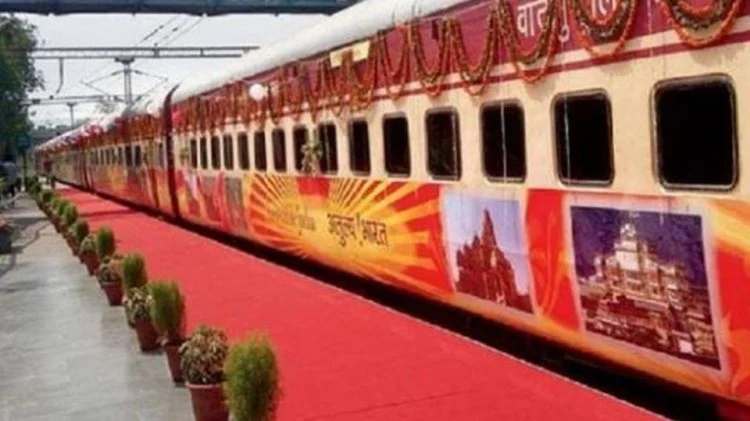0%

Bharat Gaurav train.
KATHMANDU: The theme-based Bharat Gaurav train is aimed at showcasing India’s rich cultural heritage and historical places to the people of India, and from abroad.
What is Bharat Gaurav Scheme?
In November 2021, the Indian Railways gave permission to private companies to run theme-based Bharat Gaurav trains in a bid to “showcase India’s rich cultural heritage and historical places to the people of India, and from abroad”, according to hindubusinessline.com.
The scheme will leverage the strengths of professionals in the tourism sector to run theme-based trains, it said.
The scheme is similar to IRCTC’s theme-based tourist trains like the Ramayana Express, which goes on a tour of several places connected to Lord Ram.
How does it work?
Any operator can lease trains from Indian Railways to run on a theme-based circuit as a special tourism package, the hindubusinessline.com has said.
The operator has the freedom to decide the route, the halts, the services provided and most importantly the tariff. For using Bharat Gaurav Trains, a prospective service provider has to register to place the demand for rake of Bharat Gaurav trains.
The service provider can take custody of the trains for a minimum period of two years and a maximum period up to the residual life of the coaches.
The composition of the rake shall be a minimum of 14 coaches and a maximum of 20 coaches, including mandatory 2 SLRs (Guard Vans). The Railways will provide the loco and guard.
Has it become operational?
According to the hindubusinessline.com, the Bharat Gaurav train commenced on June 14 from Coimbatore North to Sainagar Shirdi.
As many as 1,100 passengers boarded the maiden roundtrip service from Coimbatore to Shirdi.
The train had stoppages at Tiruppur, Erode, Salem, Yelahanka, Dharmavaram, Mantralayam Road and Wadi.
The Train has a stop at Mantralayam Road station for five hours to facilitate darshan at Mantralayam temple.
Why is the scheme significant?
The Tejas Express on the Lucknow-Delhi route launched in 2019 was Railways’ first experience of running a train by non-railway operator and its own subsidiary IRCTC.
However, Bharat Gaurav scheme is significant on two major counts – the first is it allows private players with domain knowledge in the tourism sector to run these special trains.
This was hitherto taken care of by the IRCTC. The second is Railways gets an incremental revenue from a new stream of business.
This could pave way for more privatisation moves in running of both cargo and passenger trains.
How will Indian Railways get revenue?
Under the Bharat Gaurav scheme, the Railways will get revenue in the form of Right to use charges for the rakes; haulage charges; empty haulage charges and stabling charges.
Registered Service Providers will have the flexibility to decide the business model including themes, routes, Itinerary and tariff.
The service providers are given the naming rights; third party advertisements rights and branding rights.
India’s firsts Bharat Gaurav train named South Star Rail is run by Future Gaming & Hotel Services Pvt Ltd.
Southern Railway would get a total fixed annual revenue of Rs. 3.34 crore – an annual Right to use charges and towards fixed haulage charges.
In addition, variable haulage charge for the 5-day trip from Coimbatore to Sainagar, Shirdi and back will accrue to Southern Railway.
Similar variable charges will be collected for every trip depending on the itinerary.
Who is responsible for rail-accident claims and insurance?
Mandatory insurance of the tourists shall be the liability of the service provider and the Railways shall bear no liability in this regard.
All liability arising out of accident/untoward incident will be borne by the Indian Railways based on Accident Inquiry Report.
What has been the response to this scheme?
The scheme is seen by some as a boon to the people who want to explore the country’s vast tourism places.
However, some look at this scheme as a first major move to privatise the Railways, a view refuted by officials.
In fact, when the first train was flagged off at Coimbatore, a group of Railway employees staged a demonstration at the city railway station.
(Inputs from thehindubusinessline.com)